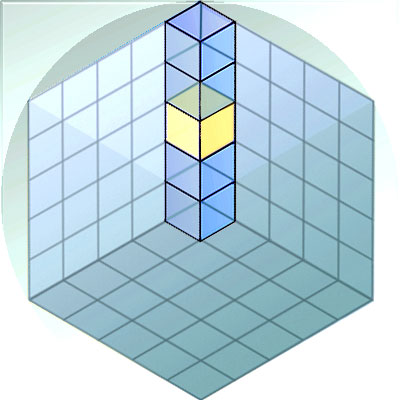002 Verse 3
Book – Chapter – Verse – previous I next – Verse – Chapter – Book


VOID ( VOID ( VOID ( LINE ) ) )
VOID ( VOID ( VOID ( PLANE ) ) )
A line is the shortest possible distance between two points.
Lines of al lengths contain an infinite number of points.
Lines can be infinite in length but still lack thickness or breadth.
Progressing from ‘virtual’ to ‘real’ the line eventually becomes manifest with the introduction of a third point, shifting the geometrical perspective from an infinitely saturated line – now ‘real’ – into a ‘virtual’ plane of infinitessimal width. The defining characteristic of all planes across the spectrum of possibilities between ‘virtual’ and ‘real’ is the possession of infinitesimal thickness.

Following on from the above definitions of a line it can be argued that a plane is the smallest possible area between three points and that planes, of all areas, from the infinitesimal to the infinite and all stages between, should contain an infinite number of infinitesimally thin lines. These two definitions deliniating the beginning and end of the plane along the spectrum from ‘virtual’ to ‘real’.
The plane is also classically associated with the idea of form. In a Platonic sense ‘idea’ and ‘form’ are interchangeable concepts. Form being a description of the surface of an object, that reveals or disguises the true nature or inner essence of its substance. Obviously this involves the implication of a three-dimensional reality of which the plane is only the surface appearance.
According to the Theory of Forms (Greek: ἰδÎαι) Socrates, as cited by Plato, speculated certain fundamental shapes to be immanent to reality. Whilst the world may appear to be constantly changing, in truth the world is comprised of an underlying changeless set of these universal forms. They are both abstract and fundamental, yet in being hidden and unseen are also the building blocks of all that exists.
Accordingly in Euclidean geometry, a Platonic solid is a regular, convex polyhedron. The faces or Platonic Surfaces are congruent, regular polygons, with the same number of faces meeting at each vertex. There are exactly five solids which meet those criteria; each is named according to its number of faces.

In a further sense the notion of a plane can be used to define the interface between two adjacent states. For example the viscous surface of a body of water, be it a raindrop or an ocean, is not a thing in itself but nevertheless has measurable characteristics indicating the existence of form. The turbulence of ocean waves is an interplay of the two dynamic masses of air and water. What is perceived is a movement predominantly associated with the ocean; rarely do we flip the gestalt to see the wave as equally an atmospheric phenomenon.

“Geometry will show the soul toward truth.”
Plato


